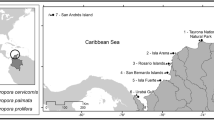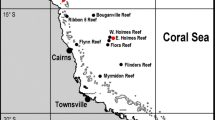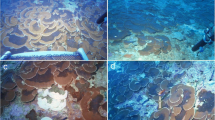Abstract
Lord Howe Island, at 31°33′S, supports the southern-most coral reef in the Indo-Pacific region, located approximately 150 and 200 km south of Elizabeth and Middleton Reefs and 1000 km south of the Great Barrier Reef (GBR). Systematic SCUBA searches in 1987 indicated that Acanthaster planci was present at 3 of 10 sites surveyed, at densities of up to 5 individuals ha-1. Further surveys in 1989 indicated that the population was increasing, with densities of 20–46 ha-1 recorded from 7 of 13 sites. The size structures of the 1987 and 1989 populations were suggestive of annual recruitment since 1985. Individuals larger than 25 cm diameter were gravid during both surveys, raising the possibility that the population may be self-seeding. Alternatively, the population may be maintained by larvae dispersed in the East Australian Current from the southern GBR or in eddies from Elizabeth and Middleton Reefs. This study provides the first records for distribution of 7 species of scleractinian coral at Lord Howe Is. Reef.
Similar content being viewed by others
References
Edwards RJ (1979) Tasman and Coral Sea ten year mean temperature and salinity fields, 1967–1976. Australian Commonwealth Scientific and Industrial Organization Division of Fisheries and Oceanography Report 88:40 p
Endean R (1974) Acanthaster planci on the Great Barrier Reef. Proc 2nd Int Coral Reef Symp 1:563–576
Glynn PW (1982) Acanthaster population regulation by a shrimp and a worm. Proc 4th Int Coral Reef Symp 2:607–612
Glynn PW, Colgan MW (1989) Defences of corals and enhancement of coral diversity by territorial damselfish. Proc 6th Int Coral Reef Symp 2:157–164
Hamon BV (1965) The East Australian Current, 1960–1964. Deep-Sea Res 12:899–921
Hutchings P (1989) Voyage to Elizabeth and Middleton Reefs. Aust Nat Hist 22:485–488
Hutton I (1986) Lord Howe Island. Conservation, ACT, Australia, 157 p
Kenchington RA (1977) Growth and recruitment of Acanthaster planci (L.) on the Great Barrier Reef. Biol Conserv 11:103–118
Kettle BT, Lucas JS (1987) Biometric relationships between organ indices, fecundity, oxygen consumption and body size in Acanthaster planci (L.) (Echinodermata: Asteroidea). Bull Mar Sci 41:541–551
Lucas JS (1973) Reproductive and larval biology of Acanthaster planci (L.) in Great Barrier Reef waters. Micronesica 9:197–203
Lucas JS (1984) Growth and maturation of Acanthaster planci (L.) and hybrids in the laboratory, including observations on the effect of dict. J Exp Mar Biol Ecol 79:129–147
McCallum H, Endcan R, Cameron Ann M (1989) Sublethal damage to Acanthaster planci as an index of predation pressure. Mar Ecol Prog Ser 56:29–36
McNight DG (1978) Acanthaster planci (Linnaeus) (Asteroidea: Echinodermata) at the Kermadec Islands. New Zealand Oceanographic Institute Records (Wellington), 4:17–19
McNight DG (1979) Acanthaster planci (Linnaeus) (Asteroidea: Echinodermata) in the northern Tasman Sea. New Zealand Oceanographic Institute Records (Wellington) 4:21–23
Moran PJ (1986) The Acanthaster phenomenon. Occanogr Mar Biol Ann Rev 24:379–480
Moran PJ, Bradbury RH, Reichelt RE (1988) Distribution of recent outbreaks of the crown-of-thorns starfish (Acanthaster planci) along the Great Barrier Reef: 1985–1986. Coral Reefs 7:125–137
Olson RR (1987) In situ culturing as a test of the larval starvation hypothesis for the crown-of-thorns starfish, (Acanthaster planci). Limnol Oceanogr 32:895–904
Rowe FWE, Vail L (1984) Is the crown-of-thorns ravaging the reef? Aust Nat Hist 21:195–196
Veron JEN (1986) Corals of Australia and the Indo-Pacific. Angus and Robertson, Sydney Australia, 644 p
Veron JEN, Done TJ (1979) Corals and coral communities of Lord Howe Island. Aust J Mar Freshwater Res 30:203–236
Yamaguchi M (1987) Occurrences and persistency of Acanthaster planci pseudopopulation in relation to oceanographic conditions along the Pacific coast of Japan. Galaxea 6:277–288
Zann L, Brodie J, Berryman C, Naqasima M (1987) Recruitment, ecology, growth and behaviour of juvenile Acanthaster planci (L.) (Echinodermata: Asteroidea). Bull Mar Sci 41:561–575
Author information
Authors and Affiliations
Rights and permissions
About this article
Cite this article
De Vantier, L.M., Deacon, G. Distribution of Acanthaster planci at Lord Howe Island, the southern-most Indo-Pacific reef. Coral Reefs 9, 145–148 (1990). https://doi.org/10.1007/BF00258226
Accepted:
Issue Date:
DOI: https://doi.org/10.1007/BF00258226




